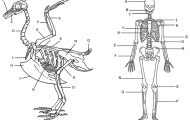

In this scenario, individual rock pocket mice can have one of three (D) is dominant to the allele for light-colored fur (d). For simplicity, we will work with two alleles at one gene. That’s why there is a range ofįur color from very dark to light.
#ROCK POCKET MOUSE GENETICS LAB CODE#
In rock pocket mice, several genes code for fur color. You can think of it as allowing for both genotypes Aa and aA.
For heterozygotes, we must allow for either the mother or the father to contribute the dominant and recessiveĪlleles. If q represents the frequency of the a allele, then the frequency of the genotype aa will be q × q, or q 2. If p represents the frequency of the A allele, then the frequency of the genotype AA will be p × p, or p 2. Let’s look at each genotype one by one to understand the equation: The second equation says that 100% of individuals in the population will have one of these genotypes: AA, Aa, and aa. The first equation says that if there are only two alleles for a gene, one dominant and one recessive, then 1 00 % of theĪlleles are either dominant (p) or recessive (q). Two equations are used to calculate the frequency of alleles in a population, where p represents the frequency of theĭominant allele and q represents the frequency of the recessive allele: If allele frequencies or genotype frequencies change over time, then evolution is In equilibrium, the overall number of A alleles and a alleles in the gene pool will remain constant, as will the proportion of Each individual has one of three genotypes: AA, Aa, or aa. Suppose,įor example, a gene has two alleles, A and a. To determine whether a population’s gene pool is changing, we need to be able to calculate allelic frequencies. The population is very large and well mixed. Population is in equilibrium (and is therefore not evolving) when all of the following conditions are true: Number of alleles present in a population at any given point in time.” According to the Hardy-Weinberg theorem, a The genetic definition of “evolution” is “a change to a population’s gene pool.” “Gene pool” is defined as “the total Natural Selection and AdaptationĪllele and Phenotype Frequencies in Rock Pocket Mouse Populations LESSON STUDENT HANDOUT Natural Selection and Adaptation PART 1: REVIEWING THE PRINCIPLES OF THE HARDY-WEINBERG THEOREM After watching the film, complete Parts 1‒3 that follow. What is the genetic basis of the trait? _ _Ģ. How does this trait affect the survival of the mice in different environments? _ _ _Ĭ. What specific trait did researchers study in this investigation? _ī. Watch the short film The Making of the Fittest: Natural Selection and Adaptation. Hhmi/biointeractive/classroom-activities-battling-beetles.ġ. Examples of other fitness-related traits that researchers areĬurrently investigating are resistance to the pesticide warfarin in rats, tolerance to heavy metals in plants, and antibioticĬomputer and the Selection Coefficient file found under the “Survival of the Fittest-Battling Beetles” activity at The underlying gene or genes for a given adaptation. In this type of research, investigators try to find Investigating the adaptive value of different coat colors in rock pocket mice is an example of how scientists areĪttempting to connect genotype with phenotype for fitness-related traits. 
In particular, they were interested in understanding the forces that shape genetic variation Michael Nachman of the University of Arizona and his colleagues have spent many years researching the genetics ofįur color in rock pocket mice. These areas of dark volcanic rock range in age from 1,000 to more than 1ĭr. Volcanic rocks that formed from cooling lava. Here and there, however, separated by several kilometers of light-colored substrate, are patches of dark Most of the desert landscape consists of light-colored Substrate, or surface material, that make up the rocky desert floor. Occur widely in the area-a light-colored variety and a dark-colored variety. Populations of rock pocket mice are found all over the Sonoran Desert in the southwestern United States. What’s so special about this little mouse? Is 172 millimeters long from its nose to the end of its tail, which is shorter than an average pencil. The tiny rock pocket mouse weighs just 15 grams, about as much as a handful of paper clips. Allele and Phenotype Frequencies in Rock Pocket Mouse Populations Published August 2012 Updated August 2015 LESSON STUDENT HANDOUT ALLELE AND PHENOTYPE FREQUENCIES IN ROCK POCKET MOUSE POPULATIONS INTRODUCTION






 0 kommentar(er)
0 kommentar(er)
